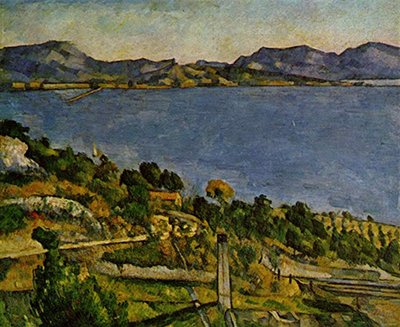Paul Cezanne always found inspiration from his native region because he remained deeply attached to it, which was depicted by his repeated emblematic motifs. He derived great enthusiasm from the fishing village of L'Estaque.
It is from this region that Cezanne created his first paintings of the seascapes in the year 1876.
Location
The painting is set at a bay in L'Estaque with a viewpoint that gives a viewer to look down over the bay and perceive the richness of the bay. The details of this painting are clearly outlined in his letter to his teacher and friend Camille Pissarro. From the letter, Cezanne is seen to compare the view of the pay to that of a playing card because of the simplicity in colours and shapes that really fascinated him. The configuration of the landscape had him enthused. He divided the painting into zones of four-water, sky, mountain and the architecture.
Technique
Most Impressionist painters used elements such as sky, water and mountains to depict the transient effect of light. Cezanne was a different case. His technique in the painting was fundamentally to define the composition and structure of the views he painted. He painted this painting on canvas utilising defined and contrasting colours juxtaposed by a complex grid of diagonal, horizontal and vertical lines and the result was a highly compact and more dynamic patterns of the village, the water and the sky. Furthermore, he used block-like brushstrokes that were instrumental in building the element of space that left a painting with both two and three dimensional effect. This enabled him create paintings that had a sense of space and volume that brought this painting to life.
Influences
Paul Cezanne's greatest influence and inspiration was his teacher and friend Camille Pissarro. He was instrumental in enabling him lighten his palette. Because of him, Cezanne started working outdoors using a wider range of colours for his paintings. He also spent a great deal of time with Claude Monet who helped him brighten up his palette. Other names are Édouard Manet, Eugène Delacroix, Gustave Courbet and Théodore Géricault. Most of his paintings drew inspiration from nature, especially the beauty of his home region.
Cezanne was a great Impressionist painter whose works have have continued inspiring many artists till date. Some of the noteworthy names that Paul Cezanne inspired and influenced their work include Pablo Picasso, Arshile Gorky, Georges Braque, Henri Matisse and Wassily Kandinsky. His greatness not only inspired and people but also influenced artistic movements like Cubism, Fauvism, Abstract Expressionism, Expressionism and Post-Impressionism.




